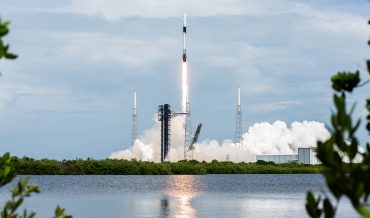
- NASA
- Space Tech
Amazon Launches 24 Kuiper Satellites via SpaceX Falcon 9 Rocket
5 minute read

Amazon’s satellite internet network gains momentum as SpaceX launch brings total Kuiper constellation to 78 operational satellites
Key Takeaways
- Amazon deploys 24 Kuiper satellites via SpaceX in a strategic collaboration between direct competitors to meet FCC regulatory deadlines for satellite internet deployment.
- Half of constellation must be operational by July 2026 as Amazon races to comply with federal licensing requirements for its 3,236-satellite network targeting underserved communities globally.
- Multi-billion dollar investment includes 80 launch contracts as Amazon challenges SpaceX’s Starlink dominance in the low Earth orbit broadband market with advanced communications satellites.
Introduction
Amazon launches 24 Project Kuiper satellites aboard a SpaceX Falcon 9 rocket, marking an unprecedented collaboration between direct competitors in the satellite internet market. The launch represents a critical milestone in Amazon’s race to deploy more than 3,200 satellites and challenge SpaceX’s Starlink dominance.
This partnership emerges from necessity rather than choice, as Amazon faces strict regulatory deadlines while grappling with limited launch capacity from its preferred providers. The mission highlights the complex dynamics reshaping the commercial space industry.
Key Developments
SpaceX targets Wednesday morning for the Falcon 9 launch of the KF-01 mission from Space Launch Complex 40 at Cape Canaveral Space Force Station. The 27-minute launch window opens at 2:18 a.m. ET, with a backup opportunity available Thursday at 1:57 a.m. ET.
Amazon secured this launch through a three-launch deal with SpaceX signed in December 2023. The agreement stems from Amazon’s urgent need to meet FCC licensing requirements, which mandate deployment of at least half of its initial Kuiper constellation by July 2026.
The mission utilizes the maiden flight of Falcon 9 booster B1096, with the first stage expected to land on the droneship “A Shortfall of Gravitas” in the Atlantic Ocean. The 24 satellites will deploy at 289 miles above Earth across three orbital layers at altitudes of 590 km, 610 km, and 630 km.
Market Impact
The 45th Weather Squadron provides an 80% chance of favorable launch conditions, supporting investor confidence in the mission timeline. This launch brings Amazon’s total Kuiper satellites in orbit to 78, demonstrating accelerated deployment capabilities.
Amazon’s reliance on SpaceX rockets previously triggered shareholder litigation, as investors questioned the company’s initial decision to overlook the industry’s most reliable launch provider. The Falcon 9’s proven track record now serves Amazon’s aggressive deployment schedule.
The collaboration signals shifting competitive dynamics in the commercial space sector, where market leaders increasingly depend on each other’s capabilities to meet regulatory and business objectives.
Strategic Insights
Amazon’s Project Kuiper represents a strategic expansion beyond e-commerce and cloud computing into the global broadband market. The company targets underserved communities worldwide, positioning itself to capture revenue from areas where traditional internet infrastructure remains limited.
The 3,236-satellite constellation directly challenges SpaceX’s Starlink network, creating a duopoly in low Earth orbit internet services. This competition drives innovation while potentially reducing costs for end consumers through market forces.
Amazon’s multi-billion-dollar investment includes 80 launch contracts across multiple providers, demonstrating the capital intensity required to compete in satellite internet services. The company’s approach emphasizes redundancy and timeline management over exclusive partnerships.
Expert Opinions and Data
Industry analysts view Amazon’s use of SpaceX services as pragmatic rather than preferential, given the company’s regulatory constraints and limited alternatives. According to Reuters video, United Launch Alliance has successfully launched the first two batches of Kuiper satellites, while Blue Origin’s New Glenn rocket remains largely untested with only one flight completed.
The technical specifications reveal Amazon’s satellites operate as advanced communications platforms designed for global coverage. The three-layer orbital configuration optimizes signal strength and reduces latency for ground-based users.
Weather conditions and backup launch windows demonstrate the operational complexity of coordinating multiple satellite deployments within compressed timeframes. The 27-minute launch windows reflect precise orbital mechanics requirements for constellation placement.
Conclusion
Amazon’s partnership with SpaceX underscores the evolving nature of competition in the commercial space industry, where rivals collaborate to meet regulatory requirements and business objectives. The successful deployment of 24 Kuiper satellites advances Amazon’s position in the global broadband market while highlighting the capital-intensive nature of satellite internet infrastructure.
The mission represents a critical step toward Amazon’s goal of providing affordable internet access to underserved communities worldwide, positioning the company as a significant competitor to established satellite internet providers.








